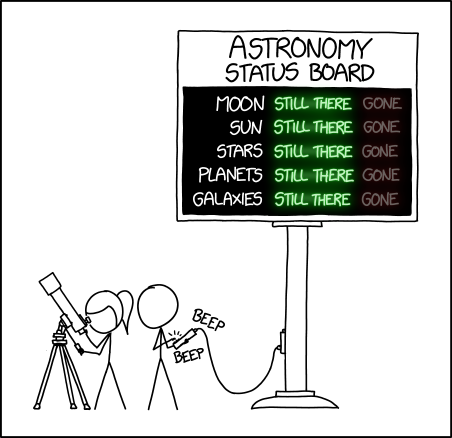May 28, 2021
#2469: Astronomy Status Board

[Ponytail is looking through a telescope, while Cueball is pressing buttons, which makes noises, on a remote control connected with a wire to a large board to their right. He controls the messages shown on this board.]
Remote: Beep beep
[The board has a black screen, with a label in a white section above the screen:]
Astronomy Status Board:
[The black screen has five rows with text in three columns. The first column is with white text. The second is in glowing green text and the last are in faded grey red text.]
Moon Still there Gone
Sun Still there Gone
Stars Still there Gone Planets Still there Gone Galaxies Still there Gone
CONDITIONS UNDER WHICH CELESTIAL OBJECTS MIGHT BE CONSIDERED “GONE”[EDIT [/wiki/index.php?title=2469:_Astronomy_Status_Board&action=edit§ion=3]]
Astronomers do regularly observe occultations [https://en.wikipedia.org/wiki/Occultation] of stars by other celestial bodies, and sometimes also search through archived images for missed occultations. This can provide information on the size and orbit of an asteroid too small to observe directly, or other useful scientific knowledge, but occulted stars are not “gone”, merely hidden. There are also a few astronomers who are searching image archives for stars that really have completely vanished without a trace [https://www.space.com/hunt-for-universe-missing-stars-space-mysteries] (or suddenly appeared), as this would be a sign of truly novel physics – perhaps even a sign of extraterrestrial intelligence – but no such vanishings have yet been identified. This comic appeared at the time the VASCO project [https://vasconsite.wordpress.com/] is receiving media attention, claiming that 800 stars visible in 70 years old photos are not seen anymore [https://iopscience.iop.org/article/10.3847/1538-3881/ab570f].
Small stars which have exhausted their hydrogen fuel without building enough heat to fuse carbon or oxygen, are theorized to eventually collapse into faint “white dwarf [https://en.wikipedia.org/wiki/White_dwarf] stars” which are of such low luminosity that they are unlikely to remain visible to the naked eye from the Earth’s surface except at very close proximities. The Earth’s sun, Sol, is generally expected to follow this progression as a low-mass main sequence [https://en.wikipedia.org/wiki/Main_sequence] star, during the latter period of its stellar evolution [https://en.wikipedia.org/wiki/Stellar_evolution]. Although some stellar models predict that relatively rapid collapses are possible, the long time scale over which stellar evolutions are believed to occur decreases the odds of observing any one specific star both before and after this transition. In this comic, individual stars are not listed; therefore “gone” is unlikely to be useful for the stars, because a great number of stars would be “still there” until well after the expected collapse of our own sun.
One of the proposed outcomes of the ultimate fate of the universe is the Big Rip [https://en.wikipedia.org/wiki/Big_Rip]. If it’s correct, all the items on the status board will eventually move from Still There to Gone, beginning with the most distant galaxies and proceeding to the the objects in our own solar system (although there will be hardly any time for the board to show Gone for the closest, especially the Moon). This scenario is dramatized in the short story “Last Contact [https://en.wikipedia.org/wiki/Last_Contact]” by Stephen Baxter.
Collisions between celestial bodies are commonly postulated as a fundamental part of the formation of planetary nebula [https://en.wikipedia.org/wiki/Planetary_nebula]. Since most mass in the known universe is observed to have a relatively low albedo [https://en.wikipedia.org/wiki/Albedo], the presence of numerous unlit, massy bodies of planetary scale and smaller is strongly indicated. This is corroborated by measurements of orbital deflection detected in many visible stars, hinting at the possibility of large planets orbiting around them, unseen due to distance & low luminosity. The possibility of one or more local planets being “gone” could be attributed to unpredicted collision with another object of similar mass or equivalent velocity. Such a collision is one possible explanation for the sudden & catastrophic disintegration of Earth’s moon, Luna, in the novel Seveneves [https://en.wikipedia.org/wiki/Seveneves] by Neal Stephenson. This hypothetical event forms the premise of this book, during which Earth’s whole sky becomes occluded by dust raised by millions of impacts across its surface & eventually by the constant incandescent descent of lunar debris itself. Again however, a single collision with any planet besides the Earth would not remove all the “Planets” from the Earth’s visible night sky, so “gone” remains unlikely to be used for that category of celestial objects.
Occlusion of Earth’s entire sky, due to airborne dust, volcanic ash, increased cloud cover, light pollution [https://en.wikipedia.org/wiki/Light_pollution], or sufficiently dense layers of high-albedo material in orbit, may be the least unlikely potential reason for all of these celestial phenomena to be flagged as “gone”. Notably, the phenomena in question would remain; only our view of them would be gone.